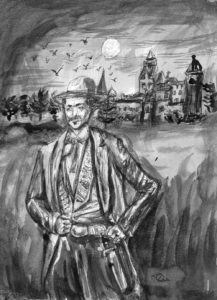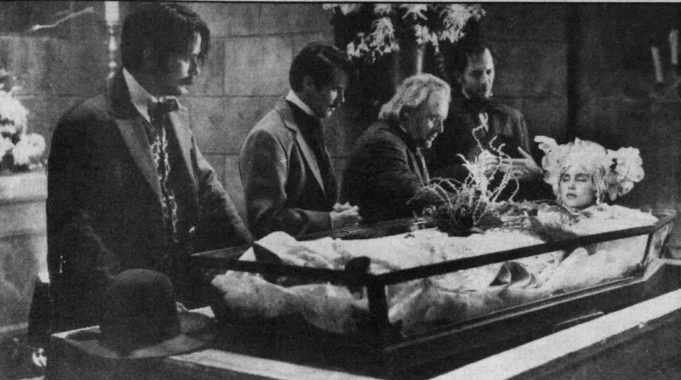To say that Texas and Texans have had a memorable imprint on modern history and culture would be a grievous understatement. Texas heroes — real and imaginary — have inspired Texans, Americans, and folks around the world since the founding of the Republic. Heck, I can remember a time in the ’80s when the whole planet was fixated on the Lone Star State, enthralled by Urban Cowboy (and super-honky-tonks like Billy Bob’s and Gilley’s), fascinated by J.R. Ewing and the uber-popular Dallas television series, and captivated by the narrative of Lonesome Dove. Everyone from Tyler to Timbuktu was nostalgic for the measures of friendship, loyalty, and love stories that sprang from Larry McMurtry’s Pulitzer Prize-winning page-turner, and Augustus “Gus” McCrae and Woodrow F. Call became household names.
It didn’t start there, of course. Dallas was prefigured by the struggles between Rock Hudson’s Jordan “Bick” Benedict and James Dean’s Jett Link in the 1956 motion picture classic Giant, which suggested Texans were ranchers or oil men — though in the ensuing years, most Texans seemed to forget which character best exemplified Texas.
Another 1956 motion picture classic, however, was arguably more influential than either. Named the greatest American Western of all time by the American Film Institute in 2008, The Searchers is considered a masterpiece and one of the most compelling yarns ever committed to celluloid. John Wayne’s Ethan Edwards is larger than life, especially set against director John Ford’s sprawling landscapes and panoramic vistas (ironically filmed mostly in Utah). But he’s also hard and scary. His hardness may have been necessary in terms of survival on the frontier, but it almost left him unfit for normal existence. It was certainly a far cry from Ethan Edwards’ predecessor, The Lone Ranger, another Texan riding the frontier trying to right wrongs. In fact, the black-and-white Lone Ranger television series began in 1949 and ran until 1957, when Wayne’s Edwards made the Ranger seem quaint.
The origins of the Texas hero archetype began at the Alamo, of course, and specifically in the tales of Davy Crockett, Jim Bowie, and William Barret Travis. Travis’ famous letter commenced with a forward-thinking, ambitious salutation: “To the People of Texas and All Americans in the World.” It ended with his declaration “VICTORY or DEATH.” And legend has it, they all died.
We all know the story. It’s taught in every Texas school. The Alamo was our Thermopylae and Travis was our own King Leonidas. The tale was the Lone Star State’s only real, far-reaching cultural reference until well after the Civil War.
The heroes of the Alamo were later joined by real life WWII hero Audie Murphy, whose wartime feats dazzled patriotic Americans and war historians alike. Texas wunderkind Howard Hughes also grabbed a lot of attention and left an international footprint — but hardly as a stereotypical Texan.
In the interim between Crockett, Bowie, and Travis and the Lone Ranger, there were very few major referential figures. Cases could be made for infamous outlaws like John Wesley Hardin or Clyde Barrow, but neither was really hero or archetype material.
There was, however, another major, internationally renowned Texas hero who appeared at the end of the 19th century. In fact, he was the chief hero of one of the most popular books in human history.
But he got lost in the shuffle.
*****

Art by Chase Adrian Teal
Modern recognition of Bram Stoker’s Dracula primarily stems from the 1931 American film of the same name, starring Bela Lugosi as Count Dracula. It was horrifying for its time, incredibly successful, and, in its own right, profoundly iconic. Unfortunately, it cut the yarn’s most gallant character out of the narrative.
The actual Bram Stoker novel, published in 1897, included an additional, unsuccessful suitor for Mina Harker’s friend, Lucy Westenra. He was a Texan named Quincey P. Morris. He was tall, handsome, and fearless. He was wealthy and came from a ranching background. He was also “well-educated” and had “exquisite manners” — but he always carried a Bowie knife.
In the period that the story takes place, Morris was staying with his English friend, Arthur Holcomb, who had recently won Lucy’s affection and was her fiancée. In fact, when Morris’ affection for Lucy (whom he admires because of her “grit”) leads him to ask her, “Won’t you just hitch up alongside of me and let us go down the long road together, driving in double-harness?,” he is rebuffed. But he good-naturedly replies, “Little girl, your honesty and pluck have made me a friend, and that’s rarer than a lover; it’s more unselfish anyhow.”
Later, when Lucy inexplicably falls ill because she is slowly exsanguinated by Count Dracula, Morris is the first to recognize what is happening because he has had some experience with it:
I have not seen anything pulled down so quick since I was on the Pampas and had a mare that I was fond of go to grass all in a night. One of those big bats that they call vampires had got at her in the night, and, what with his gorge and the vein left open, there wasn’t enough blood in her to let her stand up, and I had to put a bullet through her as she lay.
Then, after Lucy is dead, Morris notices bats lingering around. When Professor Van Helsing, the Harkers, and the others gather to discuss what to do about Dracula, Morris takes leave of the conversation to dispatch a bat that’s been perched outside the parlor window where they’re holding the discussion. And when Mina is falling ill after being visited by Dracula and instructs her husband Jonathan and the others that if she starts to turn into one of the undead to kill her in such a way that she will not join the ranks of the vampire, Morris is the first to give his promise in regards to the seemingly unconscionable task:
I’m only a rough fellow, who hasn’t perhaps, lived as a man should to win such a distinction, but I swear to you by all that I hold sacred and dear that, should the time ever come, I shall not flinch from the duty that you have set us.
At the end of the narrative, when the sun is setting in the area near Dracula’s castle and the wolves are beginning to make what Dracula himself had referred to as “sweet music,” Morris and the other protagonists accost the Szgany gypsy caravan that is transporting the Count. Morris and Jonathan Harker are the first to assail Dracula’s escorts in an effort to destroy him. Mina describes the scene:
In the midst of this I could see that Jonathan on one side of the ring of men, and Quincey on the other, were forcing a way to the cart; it was evident that they were bent on finishing their task before the sun should set. Nothing seemed to stop or even hinder them. Neither the levelled weapons or the flashing knives of the gypsies in front, or the howling of the wolves behind, appeared to even attract their attention.
Jonathan Harker’s approach is less obstructed than Quincey’s and, as he achieves the cart and pushes the count’s coffin off, Mina observes:
Mr. Morris had had to use force to pass through his side of the ring of Szgany. All the time I had been breathlessly watching Jonathan I had, with the tail of my eye, seen [Quincey Morris] pressing desperately forward, and had seen the knives of the gypsies flash as he won a way through them, and they cut at him. He had parried with his great bowie knife, and at first I thought that he too had come through in safety; but as he sprang beside Jonathan, who had by now jumped from the cart, I could see that with his left hand he was clutching at his side, and that blood was spurting through his fingers. He did not delay notwithstanding this, for as Jonathan, with desperate energy, attacked one end of the [coffin], attempting to prize off the lid with his great Kukri knife, he attacked the other frantically with his bowie. Under the efforts of both men the lid began to yield; the nails drew with a quick screeching sound, and the top of the box was thrown back. …
The sun was almost down on the mountain tops, and the shadows of the whole group fell long upon the snow. I saw the Count lying within the box upon the earth, some of which the rude falling from the cart had scattered over him. He was deathly pale, just like a waxen image, and the red eyes glared with the horrible vindictive look which I knew all too well.
As I looked, the eyes saw the sinking sun, and the look of hate in them turned to triumph.
But, on the instant, came the sweep and flash of John’s great knife. I shrieked as I saw it shear through the throat; whilst at the same moment Mr. Morris’s bowie knife plunged into the heart.
Dracula abruptly turns to dust, and Morris subsequently sinks to the ground, blood still gushing from his abdomen.
Jonathan and Mina rush to Quincey’s side. He lays his head on Jonathan’s shoulder and takes Mina’s hand, telling them “I am only too happy to have been of service.”
As Quincey dies, a “gallant gentleman,” his last words are “The curse has passed away.”
Some years later, the Harkers’ son is born on the same day Quincey Morris perished, and they decide to call him Quincey.
*****
In one of the most universally familiar works of world literature, Quincy P. Morris is key to saving the day, and readers of Dracula have been familiar with him for 120 years. But when moving pictures began to supplant the printed page, he disappeared on the cutting room floor.
The first motion picture to feature Dracula is a lost Hungarian film called Dracula’s Death. Produced in 1921, it includes an original narrative and followed Stoker’s novel only in the title. The following year, the brilliant German director F.W. Murnau filmed Nosferatu. Since the production company for Nosferatu was unable to get permission to adapt the film from Dracula (from Bram Stoker’s widow, Florence), the script featured changes to several characters and plotlines in an unsuccessful attempt to avoid litigation. Dracula became “Orlok,” Jonathan Harker became “Thomas Hutter,” and so on. And Lucy Westenra and all of her suitors — including Quincey Morris — were eliminated.
In 1923, Florence Stoker licensed Dracula to playwright Hamilton Deane, whose 1924 stage play adaptation toured England for several years. In 1927, American producer Horace Liveright employed John L. Balderston to revise Deane’s script before its American premiere. Balderston significantly abridged the narrative, changing or eliminating several characters, including, again, Quincey Morris. The 1931 American film Dracula simply followed the prevailing stage versions.
Bram Stoker’s Dracula has been translated into every major language and has never been out of print. It has inspired 750 films, and more than 200 feature Dracula himself in a major role. Stoker’s bloodsucker has gone on to become a global phenomenon, but — excluding Francis Ford Coppola’s 1992 film Bram Stoker’s Dracula — the tall Texan largely responsible for the vampire’s demise has been almost entirely forgotten, even by most Texans. l
E.R. Bills is the author of Pendulum Grim and the editor of Road Kill: Texas Horror by Texas Writers, Vol. 5.












